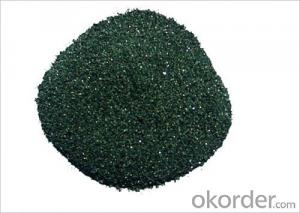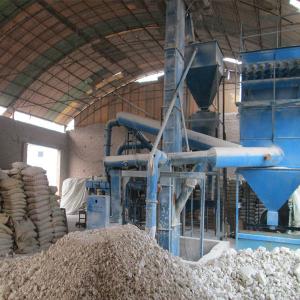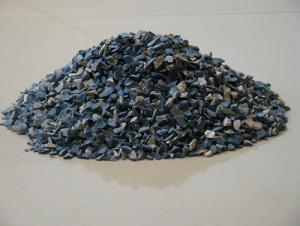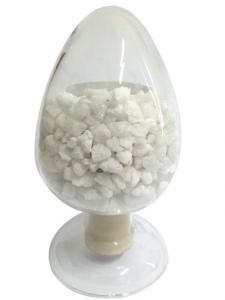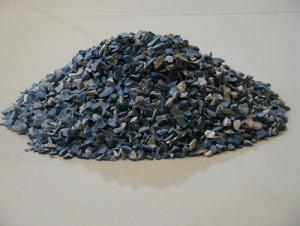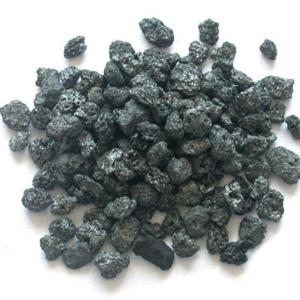99% Pure SIC Powder Nano Silicon Carbide Refractory
- Loading Port:
- China main port
- Payment Terms:
- TT OR LC
- Min Order Qty:
- 25 m.t.
- Supply Capability:
- 2000 m.t./month
OKorder Service Pledge
OKorder Financial Service
You Might Also Like
Quick Details
| Place of Origin: | Henan, China (Mainland) | Shape: | Block | Material: | Silicon Carbide (SiC), Silicon Carbide |
| Refractoriness (Degree): | Common (1580°< Refractoriness< 1770°) | SiC Content (%): | 97 | Model Number: | DRC |
| Brand Name: | CNBM | Usage: | Refractory | Color: | Black |
| F.C content: | 0-10% | S content: | <0.3%< p=""> | H2O: | <1%< p=""> |
| Particle mm: | 0-200 | BD: | 3.2g/cm3 | Performance: | DEOXIDIZER |
| SAMPLE: | Free |
Packaging & Delivery
| Packaging Details: | Silicon Carbide packing: ton bags with small 10 kg bags inside, or according to requirement. |
| Delivery Detail: | 10-30 days according to Silicon Carbide quantity |
Specifications
Silicon Carbide:
1) High SIC content: 97.0%
2) Professional manufacturer
3) Owning Exporting License
99% Pure SIC Powder Nano Silicon Carbide Refractory
Silicon Carbide Relate Information
Product Description
DETAILED DESCRIPTION
Silicon Carbide (Black) is a high purity black silicon carbide refractory grain, which is made by fusing quartz and coke in high power electrical furnace. It characterizes the
high hardness, wear resistance ability, corrosion resistance ability and high-tempera-
ture strength. It is mainly used as deoxidizer in steelmaking process.
Silicon carbide deoxidizer is a new kind of strong compound deoxidizer can replace the traditional silica fume, it has more stable and dioxin effect, improved the quality of the steel, reduced the consumption and environmental pollution.
APPLICATION
1. The silicon carbide with low SIC content around 85% is always used in the metallurgy industry, as one deoxidize material.
2. With the SIC content is above 95%, because of its high refractory temperature, it is always used in the refractory industry.
PHYSICAL PROPERTIES:
Item | Specifications |
BD | 3.2g/cm3 |
Size | 0-1mm,1-3mm,10-30mm, 36-800mesh, F16-F800 mesh |
Usage | Refractory, Casting |
CHEMICAL INDEXES:
Items | DRC97 | DRC88 |
Sic | >97 | 85±2 |
C | 0-5 | 5-10 |
S | <0.3< span=""> | <0.3< span=""> |
H2O | <1< span=""> | <1< span=""> |
Particle mm | 0~200 | ≤5 |
Performance | New deoxidizer, deoxidization fast, ability and stably. | |
Application | Steel metallurgical deoxidizing | |
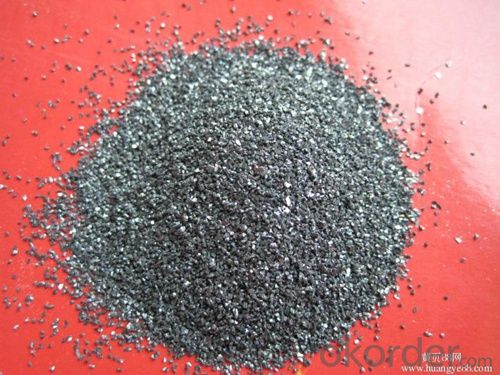
SIZES AVAILABLE:
20-0mm, 10-0mm, 8-5mm, 5-3mm, 3-1mm, 1-0mm,
8/16mesh, 16/30mesh, 30/60mesh, 60/90mesh,
0-100mesh, 0-200mesh, 0-325mesh,
Other size available upon request.
- Q:What's the maximum temperature that the refractory ceramic fiber cloth can endure?
- It depends on the composition of the ceramic material. If its composition is alumina and it is used by civilians, its normal use temperature is 1200℃; if its composition is alumina but it is for millitary use, it can endure the highest temperature of 2200℃.
- Q:How to use fire-resistant soil?
- It can live with water, not too sticky. Don't be too thin. It's best to put the stove in the inner wall.
- Q:What's the frequently used refractory material?
- What's the frequently used refractory material in the market? It is usually classified into four categories: Common Refractory: silica?brick, semi-silica brick, refractory fireclay block, high alumina refractory brick, magnesia brick, etc. Unshaped Refractory: repairing?mass, ramming refractory, refractory castable, plastic refractory, refractory mortar, gun-mix refractory, sling refractory, refractory coating, lightweight refractory?castables, stemming, etc. Special Refractory: AZS brick, corundum brick, direct-bonded?magnesia-chrome?bricks, carborundum brick, silicon nitride bonded silicon carbide brick, nonoxide refractories like nitride, silicide, sulfide, boride and carbide, and oxide refractories like calcium oxide, chromium hemitrioxide, alumina, magnesium oxide and beryllia, etc. Fireclay Insulating Refractory: diatomite product, asbestos product, insulation?board, etc.
- Q:What is the material composition of the new fire-resistant coating?
- New fire-resistant coating generally consists of base material, dispersion media, flame retardants, fillers, additives (plasticizers, stabilizers, waterproofing agents, moisture, etc.). (1) Base material is the basis of the composition of the coating, and it is the main film-forming substance, playing a decisive role in coating performance . For fire-resistant coating, its base material must be capable of matching with the flame retardant to constitute an organic fireproofing system. The base material commonly employed at home and abroad includes inorganic and organic film-forming material. Inorganic film-forming materials include silicate. Si03, K2 Si03Na2 Si03), silica and phosphate [Al. (HPO.). ] ect. There are a wide range of organic film-forming substance, usually flame retardent organic synthetic resins, such as phenolic resins, halogenated alkyd resins, polyester, halogenated olefin resins (such as vinyl chloride resin), amino resin (melamine resin, urea resin, etc. ), tar-based resins, furan resins, heterocyclic resins (e.g., polyamide-imide, polyimide, etc.), organic elements resins (e.g. silicone resin), rubber (halogenated rubber such as chlorinated natural rubber) and so on. There are numerous latex taking water as solvent. www.hc3600.
- Q:What high-molecular polymers can be used as fire-resistant material binder?
- Melamine resin should be compounded with fire-resistant material and acrylic acid material is easy to burn. But high-molecular polymers can be used along with the above two. Polysulfone is featured by heat resistance and high temperature resistance. Polyurethane is difficult to process and compound with fire-resistant material. Phenolic resin is not easy to burn. Epoxy is expensive and self-extinguishing once away from fire.
- Q:What are the insulation fireproofing materials?
- Insulated shoes, insulated gloves, tape (cloth, plastic, as well as waterproof) yellow wax tube, mouth care, fireproof (ie asbestos cloth is sold by jin) there is pressure-caps black tape, waterproof tape ,casing. There are glass fiber needle felt is widely used in electrical, chemical, construction, transportation, automotive and other industries interlayer insulation and silencer system, and used as an insulating fireproof material.
- Q:Kinds of refractory mortar
- Refractory mortar can be divided into ordinary refractory material and special refractory material. Ordinary refractory materials can be divided into acidic, neutral and alkaline refractory materials chemical properties. Special refractory material can be divided into high temperature oxide, refractory compounds and high-temperature composite materials according to their components. Furthermore, according to refractoriness, it can be divided into general refractory products (1580 ~ 1770 ℃), high grade refractory products (1770 ~ 2000 ℃) and super refractory products (2000 ℃ above). It can be divided into bulks (standard bricks, special-shaped bricks, etc.), special shapes (crucible, sagger, pipe, etc.), fibrous (aluminum silicate, zirconia filter and boron carbide , etc.) and indefinite shape (refractory clay, pouring materials and ramming mass, etc.). According to the sintering process, it is divided into sintered products, fused cast products and melting jetting products.
- Q:Who knows about the fire endurance of grade C fire doors?
- The fire endurance of grade C fire doors is no less than 0.5 hours. As the key role of family fireproofing, fire doors is particularly important. It can be classified according to the fire endurance and thermal insulation performance: The fire endurance of grade A fire doors is not less than 1.5 hours; that of grade B fire doors is not less than 1.0 hours; and that of grade C fire doors is not less than 0.5 hours. The most important property of fire doors is the fire resistance period.
- Q:Does the external wall thermal insulation materials level b1 need the fire barrier zone?
- First, the cotton fire barrier zone "rock wool board" mainly uses water-repelling rock wool board produced by pendulum method as thermal insulation layer materia, and connecting and fixing base wall by binding and nail bonding, it is composed level A non-combustible building energy efficiency thermal insulation system by plastering layer composed by plastering mortar and glass?fiber mesh and decorative mortar finishing layer or coating. Rock wool board exterior insulation system, low thermal conductivity, good ventilation, combustion performance advantages of higher levels can be used in new construction, expansion, renovation of residential buildings and public buildings energy-saving exterior wall insulation works, including exterior insulation, fire Barrier non-transparent wall insulation and EPS external thermal insulation system. The introduction of main level A fireproofing EIFS on the present market (The following text is selected from China Building Standard Design and Research Institute " external wall thermal insulation building construction" Standard No. 10J121) Second, the foam concrete fire barrier zone 1. It is very green without the release of irritant and harmful gases; no mineral cotton floats do harm to human skin and the respiratory tract; production of?toxic?gases is security level (AQ1), there is no harmful gas and waste emissions and less carbon emissions; it exist not duplicate insulation demolition waste to pollute the environment.
- Q:What is the requirement of refractory concrete for raw materials? What is the main principle of commercial mixing station?
- Refractory concrete generally divided into three categories: lightweight concrete (used in insulation); refractory concrete (for refractory temperature requirements are not very high position, and can withstand a certain air scour); heavy refractory concrete (flow with higher requirements for refractory temperature parts, and can withstand a certain intensity). Mainly depends on the design temperature and the use of parts.
1. Manufacturer Overview |
|
|---|---|
| Location | |
| Year Established | |
| Annual Output Value | |
| Main Markets | |
| Company Certifications | |
2. Manufacturer Certificates |
|
|---|---|
| a) Certification Name | |
| Range | |
| Reference | |
| Validity Period | |
3. Manufacturer Capability |
|
|---|---|
| a)Trade Capacity | |
| Nearest Port | |
| Export Percentage | |
| No.of Employees in Trade Department | |
| Language Spoken: | |
| b)Factory Information | |
| Factory Size: | |
| No. of Production Lines | |
| Contract Manufacturing | |
| Product Price Range | |
Send your message to us
99% Pure SIC Powder Nano Silicon Carbide Refractory
- Loading Port:
- China main port
- Payment Terms:
- TT OR LC
- Min Order Qty:
- 25 m.t.
- Supply Capability:
- 2000 m.t./month
OKorder Service Pledge
OKorder Financial Service
Similar products
New products
Hot products
Related keywords
